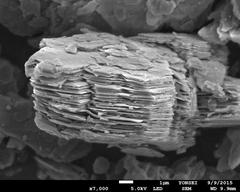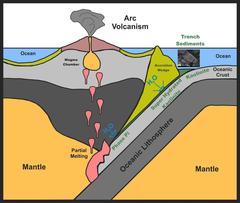URL: https://www.desy.de/news/news_search/index_eng.html
Breadcrumb Navigation
DESY News: Clay mineral waters Earth's mantle from the inside
News
News from the DESY research centre
Clay mineral waters Earth's mantle from the inside
The first observation of a super-hydrated phase of the clay mineral kaolinite could improve our understanding of processes that lead to volcanism and affect earthquakes. In high-pressure and high-temperature X-ray measurements that were partly conducted at DESY, scientists created conditions similar to those in so-called subduction zones where an oceanic plate dives under the continental crust. The transport and release of water during subduction causes strong volcanic activity. An international team led by scientists of Yonsei University in the Republic of Korea, presents the results in the scientific journal Nature Geoscience.

Ordinary kaolinite under an electron microscope. Credit: Yonsei University, Yongjae Lee
Since these processes take place many kilometres under Earth’s surface, it is impossible to observe them directly. Even the Kola Superdeep Borehole in Russia, the deepest borehole on Earth, reaches no deeper than 12,262 metres. One way to learn more about the transformations in greater depths of subduction zones is to create similar conditions in the laboratory. High-pressure and high-temperature measurements allow scientists to take a close look at the structural changes in the different minerals that form the crust and sediments.
One of these minerals is kaolinite, a clay mineral containing aluminium that is an important part of the oceanic sediments. The scientists were now able to observe the formation of a new phase of the mineral, so-called super-hydrated kaolinite. They examined a sample of kaolinite in the presence of water at pressures and temperatures corresponding to those at different depths in subduction zones. With X-ray diffraction and infrared spectra measurements, structural and chemical changes were characterized.

Kaolinite sinks into the subduction zone with the oceanic plate. As it changes into the newly discovered phase it takes in water from its surroundings and releases it upon further structure change down in the mantle. Credit: Wikimedia Commons, MagentaGreen (modified) CC BY SA 3.0 Linkhttps://commons.wikimedia.org/wiki/File:Volcanic_Arc_System_SVG.svg
In measurements carried out at the Extreme Conditions Beamline P02.2 at DESYs X-ray source PETRA III, the scientists examined the breakdown of the new phase at even higher pressures and temperatures. “Our beamline provides an environment to investigate samples at extreme pressures and temperatures. Using a so-called graphite resistive heated diamond anvil cell, we were able to observe the changes at a pressure of up to 19 Giga-Pascal and a temperature of up to 800 degrees,” says DESY-scientist Hanns-Peter Liermann of the Extreme Conditions Beamline who co-authored the study. The super-hydrated kaolinite broke down at 5 Giga-Pascal and 500 degrees, two additional transformations happened at higher pressures and temperatures. During these transformations, the water that was intercalated in the kaolinite is released.
The observation of the formation and breakdown of the super-hydrated kaolinite bears important information about the processes that occur over a depth range of about 75 kilometres to 480 kilometres in subduction zones. The release of water that takes place when the super-hydrated kaolinite breaks down could be an important part of the water cycle that causes volcanism along subduction zones. The breakdown probably happens below a depth of about 200 kilometres, the released water could then contribute to the formation of magma. Additionally, the super-hydrated kaolinite could influence seismicity. During the formation of the new phase, the water that surrounds kaolinite is removed from the environment. This could change the friction between the subducting and the overlying slabs. The scientists assume that other minerals in the sediment or crust could undergo similar transformations. Thus, the study could improve the understanding of the geochemical processes in subduction zones of the earth.
Scientists from Yonsei University in the Republic of Korea, from the US National Accelerator Laboratory SLAC, from the Center for High Pressure Science & Technology Advanced Research in Shanghai, China, from George Washington University in the U.S., from Lawrence Livermore National Laboratory in the U.S., from the University of South Carolina in the U.S., from the Carnegie Institution in the U.S. and from DESY were involved in the study.
Reference:
A role for subducted super-hydrated kaolinite in the Earth’s deep water cycle; Huijeong Hwang, Donghoon Seoung, Yongjae Lee, Zhenxian Liu, Hanns-Peter Liermann, Hyunchae Cynn, Thomas Vogt, Chi-Chang Kao, Ho-Kwang Mao; Nature Geoscience, 2017; DOI: 10.1038/s41561-017-0008-1



